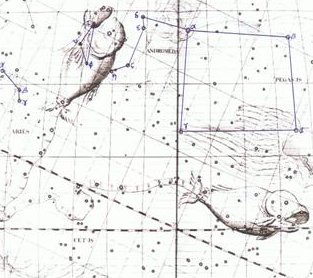9. It may be no coincidence that 64 (to be added from the end of side b) is equal to 8 * 8 and 256 (where the front side of the text apparently ends) is equal to 16 * 16. Adding 64 + 256 = 320 is another result than those 300 days which I expected to find for the front side, yet 300 days will now be exactly the number to the end of side a:
From Gb6-17 to the end of side b there are 73 or 365 / 5 glyphs. The pair of tagata could indicate that the 2nd part of a cycle ends here. But 402 - 256 = 146 = 2 * 73 supports the idea that there should be 70 glyphs at the end of side b. Perhaps there is a solution to this dilemma somewhere in the fact that 6 * 29½ = 177 is 3 less than 6 * 30 = 180. In half a year there is a 3-day long gap between the measures of Sun and Moon. The synodical cycle of Jupiter is 399 days and this also suggests there could be an interregnum of 3 days in Gb6-17--19. The G text has 472 glyphs = 256 + 216 = 8 * 32 + 8 * 27 = 8 * 59 > 365¼, and if the prominent stars in the sky roof can be put in parallel with the glyphs then there should be an overlap somewhere in the cycle, like when Ouroboros is biting his tail. Therefore, if we for example count ahead from mago in Ga7-16 and day number 186 + 64 = 250 (to coincide with the right ascension 16h 26m for α Scorpii), we perhaps can find Mirach (the girdle of Andromeda) also earlier in the text than at Gb7-14:
67m / 1440m * 365¼ = 17.0 and from 16h 26m (= 986m or 250.1 days) to the end of the right ascension cycle there are 365¼ - 250.1 = 115 days. 115 + 17 = 132 and 186 + 132 = 318:
If we add 64, then Gb3-28 will be number 383 = 13 * 29½ - ½. Perhaps we should insert a 'day zero' somewhere so as to get glyph number 318 at Gb3-28? No, Gb3-29 with a 'watery Sun eye' and the symmetrically placed maro rising feather strings probably is a sign similar in meaning to the double 'Janus eyes' in Gb7-14. And 384 = 2 * 192 is where we should look for 'another Mirach'. 32 * 9 = 288 = 2 * 12². But I cannot see any girdle or rising fish here, instead the movement is downwards. Consider a picture of Ouroboros:
Head comes first, then the arms, then legs, and then nothing. If we should guess the length of the creature from the tip of its nose to the end of its tail we could say it is 472 units long. But part of the creature is invisible, the engulfed end of its tail. If we then measure what is visible it must be shorter than 472, perhaps 360 (or some other number fitting for the solar year). The text at the beginning of side b is clearly a continuation of what can be read at the end of side a, this we can see from e.g. the resemblance between Gb1-1 and Ga8-16:
Likewise can we read a continuation from the end of side b to the beginning of side a, with 2 gagana figures followed by a single single-eyed one:
Perhaps the open jaw of Ouroboros is a sign of the bands which join in a knot at Pisces:
The 'tail' of the old year should here disappear through the 'door' of the Pegasus Square. It is plowed down into the fertile field to generate next phase in the eternal cycle of life:
|
|||||||||||||||||||||||||||||||||||||||||||||||||||||||||||||||||||||||||||||||||||||||||||||||




















